by Heather Plett | Apr 23, 2013 | Leadership, Uncategorized
“I’m finally beginning to realize that I’m a leader.”
Those are the words I heard not long ago from a woman who’d just finished the four month leadership program I was co-facilitating. She was an incredible woman doing great things in her community, including lobbying to save a local nature trail, but she’d never thought of herself as a leader.
I hear those words all the time, especially from women. I’ve been hearing them recently in relation to my online course Lead with Your Wild Heart. “I love your program… but… I’m not sure I’m a leader.” Almost without fail, these women are gifted in art, teaching, community transformation, homemaking, earth stewardship, etc., and yet they don’t see leadership in what they do.
Part of the purpose of Lead with Your Wild Heart is to re-imagine leadership for our time. I believe that the need in the world has changed and that we now need to see leadership through a new lens.
I believe that the leaders the world needs now are those who know how to host conversations, imagine change, paint, dance, sing, write poetry, love generously, live in right relationship with the earth, build community, imagine new ways of using and honouring our limited resources, teach, and play.
As Margaret Wheatley says, a leader is “anyone who is willing to help.” The world needs us to show up and help right now, with whatever gifts we have to offer.
I’ll be hosting a free call on Wednesday, May 1st, at 2 p.m. Central on Re-Imagining Leadership for Our Time.
The call will be an exploration into a new way of defining leadership that fits the paradigm we are now living in. Your questions and ideas on the subject will be more than welcome. One of my deepest beliefs about effective leadership is that it involves hosting meaningful conversations that help surface the wisdom in the circle. Your wisdom is welcome in this circle, and so are your doubts, questions, and curiosity.
I’m happy to be joined in the call by some of the members of my Wise Heart Wisdom Circle. Those who’ve confirmed so far are Desiree Adaway, Julie Daley, and Lisa Wilson.
Sign up below and you’ll receive the call information in your inbox. I look forward to our conversation!
ALSO… over on Facebook, I’m collecting “what if” questions about leadership to inspire us for the conversation. Scroll down below the sign-up form to see the ones already gathered, and add your own to the comments of this post.
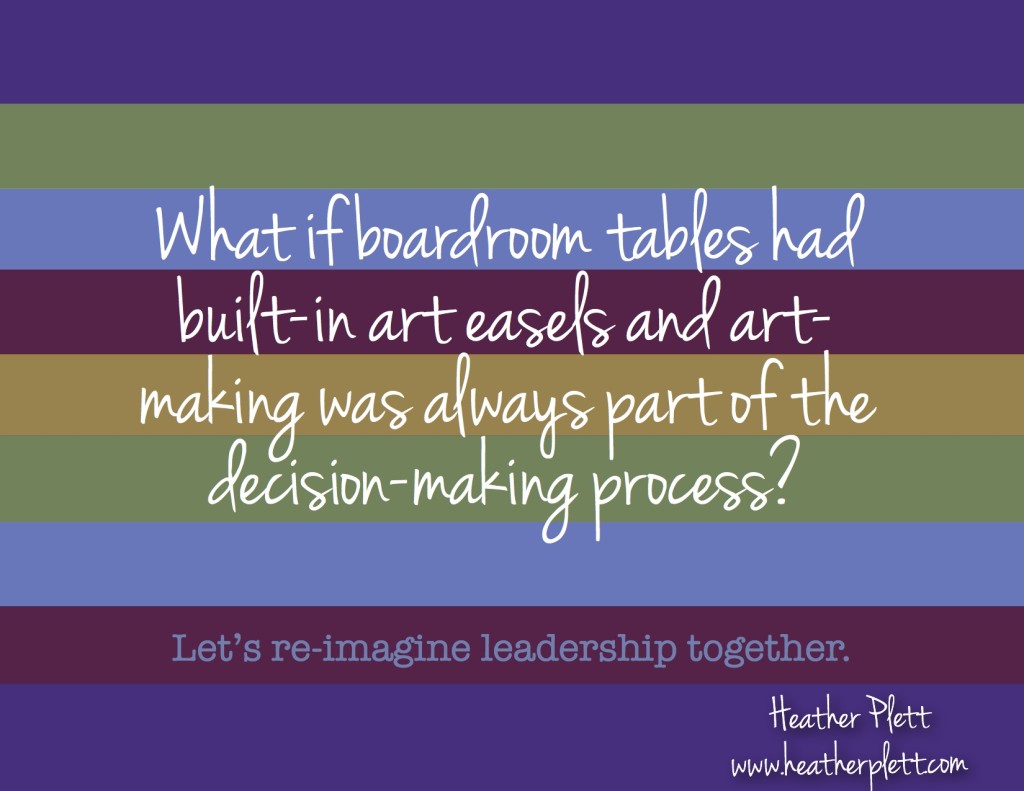
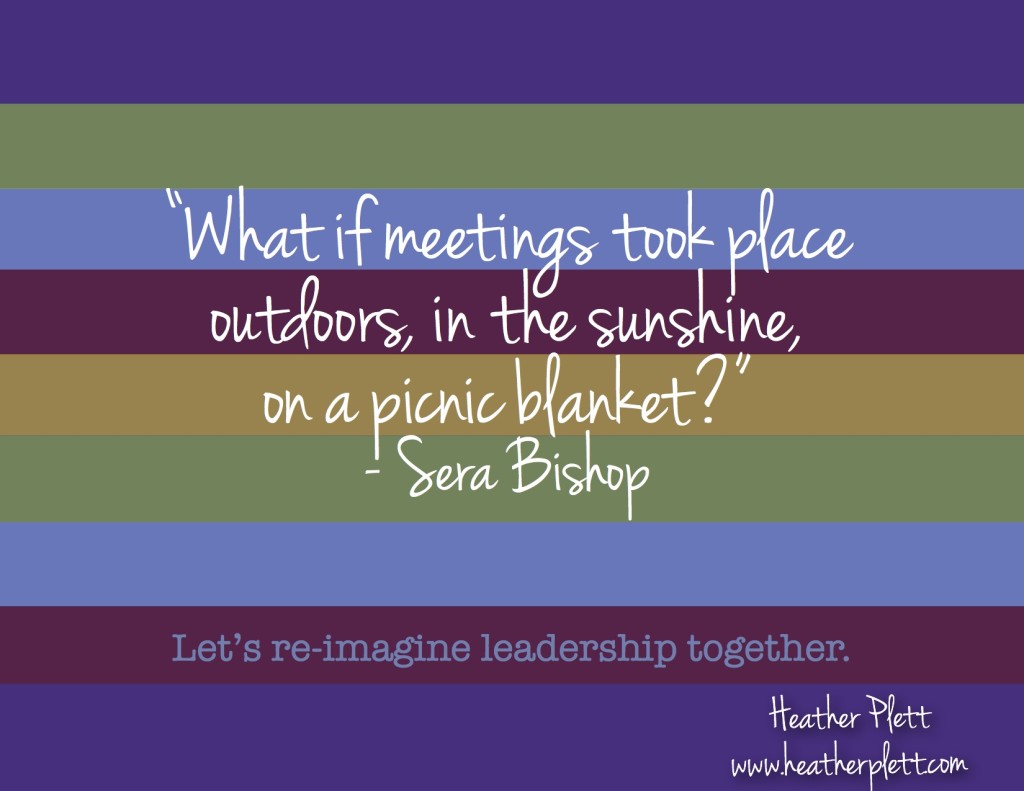
by Heather Plett | Mar 1, 2013 | circle, Community, Leadership, Passion
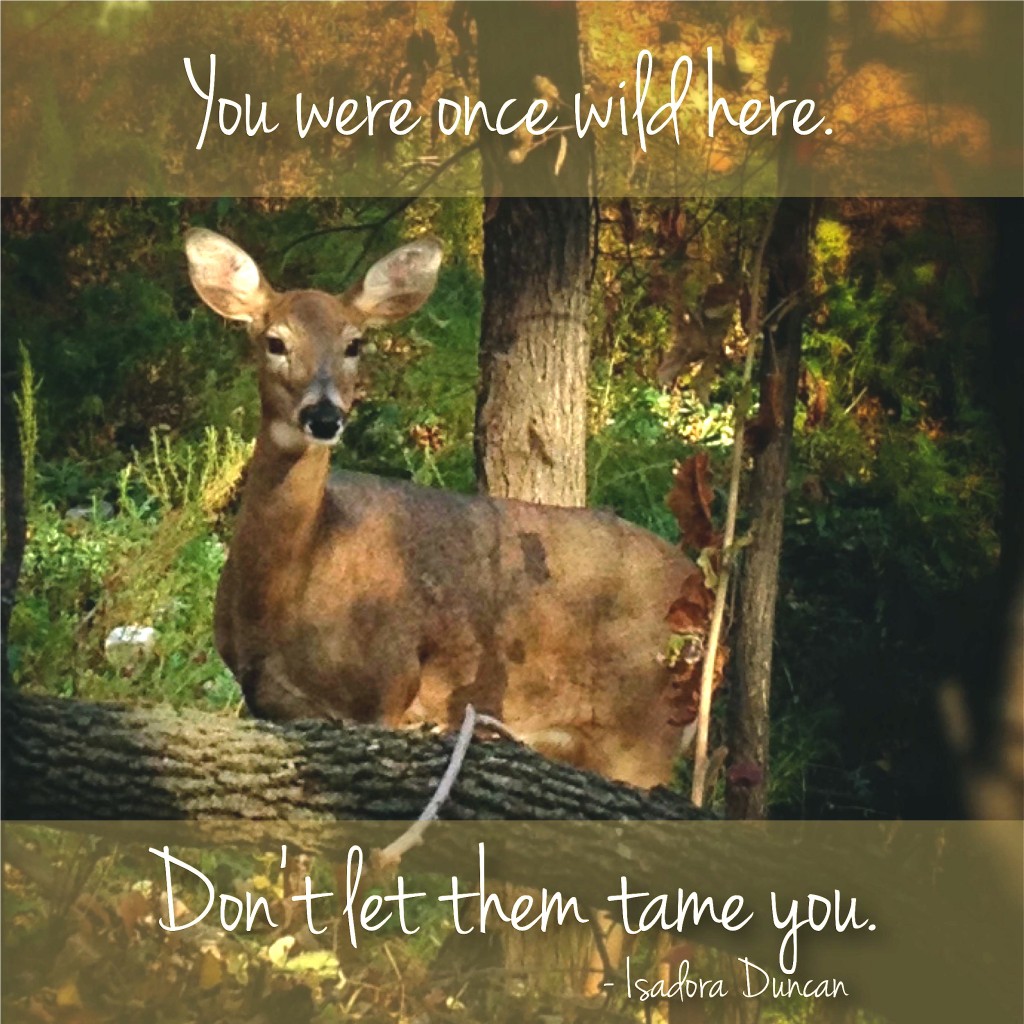
I didn’t know how much launching Lead with your Wild Heart would change my life and my business, but it has, dramatically. Interviewing the incredible members of my wisdom circle, researching, writing, and teaching this program have taught me more than any course I’ve ever taken or ever created.
In shamanic language, this feels like my original medicine – the gift I’m meant to contribute for the healing of the world. In helping women (and, in the future, possibly men) get closer to their wild hearts, I am becoming intimately familiar with my own. (The next offering will begin in May, and I expect there will be in-person offerings to come as well.)
The seeds for this course came to me one day last summer when I was wandering in my favourite woods. There are often deer in those woods, and I have such great reverence for deer that I always stop to pay attention when I see them there. Often I follow them deeper into the woods.
One particular time, I almost missed the deer that was standing completely motionless about ten feet from the path on which I walked. The deer was watching me, and when I stopped on the path, we stood locked in a visual embrace for what I think was about ten minutes but what felt like an eternity.
I walked away from that encounter with the profound sense that the deer needed me to understand something that I’d been missing before. Further along the path, it came to me. “I need to create a program called Lead with your Wild Heart. I need to teach women how to get reconnected again.”
The deer invited me back into the wild – back to my wild-hearted trust, wild-hearted love, and wild-hearted courage. Those are the things I now share with the incredible circle of women who have gathered for this program.
Sometimes my coaching clients lament that they are not very good at planning or goal-setting, and I tell them “Maybe you don’t have to be. Maybe you just need to be good at wandering in the woods and listening for the wisdom.” You won’t hear that in business school, but my best ideas have almost always emerged when I’ve found time to be silent in nature.
The deeper I go in this journey, the more I understand what it means to be wild again.
To be wild again means that:
- We are connected with the earth, the wind, the deer, and the trees.
- We are connected with each other in a deeper way than our culture encourages.
- We trust that which is primal and wild in ourselves and we offer our most natural gifts to each other.
- We trust that which is primal and wild around us and we honour the wisdom of creation.
- We remember that we are stewards and citizens rather than consumers and conquerors of this earth.
- We dare to weep when we are wounded, laugh when we are joyous, and touch when we are in need of each together.
- We reclaim the circle and gather around the fire, sharing our most vulnerable, wild stories.
- We dare to plunge the depths of our wild hearts and honour what we find there.
- We sing and dance, trusting both our voices and our bodies to be expressions of the sacred.
- We are courageous warriors, serving the cause of all that is good in the world.
- We dare to believe that the world is a good place to call home.
by Heather Plett | Feb 6, 2013 | change, circle, Creativity, Leadership, women
I have the great privilege these days of co-hosting a women’s leadership program that meets every second week in a small town an hour and a half from the city where I live. There are so many things about this that I love, including the fact that I have a regular reason to drive out into the country and see the wide open prairies and the wild, alluring woods. With no parents left to visit, I don’t get out to my rural roots often enough to suit me.
On the drive out there yesterday, we had a rare and wonderful sighting of a lynx as it dashed across the road and ran off into the snowy woods. It felt like a moment of blessing.
Yesterday’s session focused on facilitating change. The best change process I know of is Theory U, a process I was first immersed in at ALIA Summer Institute and that I’ve been a dedicated student of since.
I introduced the idea of a Change Lab, where-in we would walk through the U process by casting ourselves in the role of community leaders who recognize the need for change in how the community is organized.
I started out by sharing the story of Baba Yaga’s House in Paris, France, a home created for aging feminists by a circle of women who realized that none of the available models for seniors’ housing fit with their values or expectations of how they wanted to live. (I encourage you to listen to the podcast at the link above.) “Imagine we are these women,” I said. “We are faced with an established community model we know doesn’t work for us, and yet we haven’t found a new model that we’re comfortable with.”
From there I moved on to an explanation of Theory U, a method for co-creating social change. Instead of trying to find a direct route from challenge to solution – the way some of the more linear models do, with brainstorming, strategic planning, etc. – Theory U takes us on a deep dive into the unknown. Instead of trying to direct change, we host what is wanting to be born. Instead of trying to control, we let go and let come. Instead of expecting the future to look like the past with just a few tweaks, we invite a new future to spiral up out of the brokenness of the past.
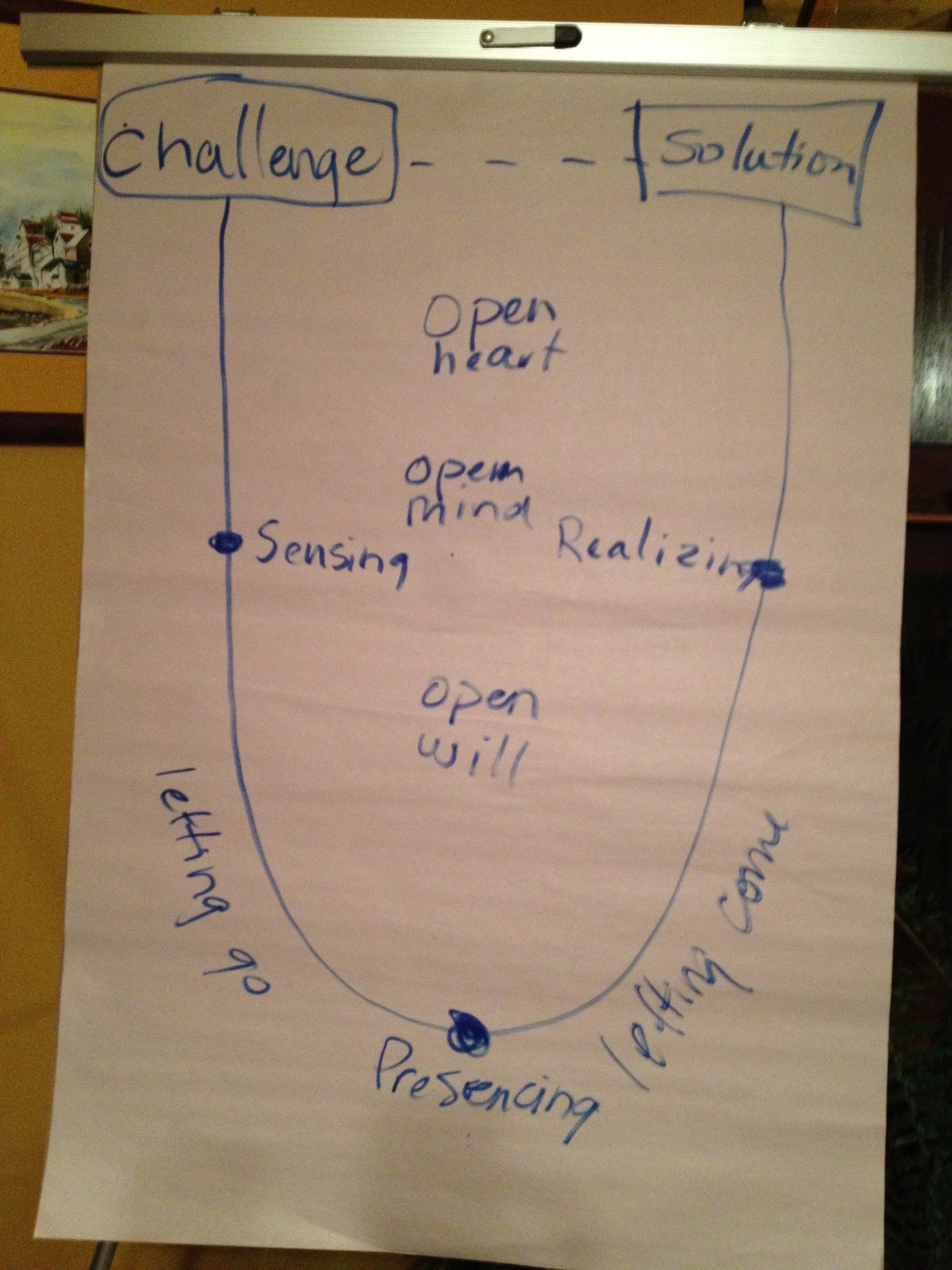 In Theory U there are three main parts – sensing, presencing and realizing. In the sensing phase, we are invited to use all of our senses to witness what is present. We are invited to suspend our judgements, opinions, assumptions and mental models, and to use our eyes and ears and the feeling of our bodies to sense into whatever the context is. We host conversations, we ask good questions, we listen deeply, we watch with full attention, and we notice how our bodies feel.
In Theory U there are three main parts – sensing, presencing and realizing. In the sensing phase, we are invited to use all of our senses to witness what is present. We are invited to suspend our judgements, opinions, assumptions and mental models, and to use our eyes and ears and the feeling of our bodies to sense into whatever the context is. We host conversations, we ask good questions, we listen deeply, we watch with full attention, and we notice how our bodies feel.
In the presencing phase, we are invited into the inner work of grounding ourselves in our bodies and paying attention to what is emerging. We listen into the space and learn from the future as it emerges, letting go of our expertise and experience. Rather than moving directly into problem solving or brainstorming, we take time for retreat and reflection. The best place for presencing is outside in nature where we ground ourselves in the earth and lean into the trees.
The third phase is Realizing. In this phase – on the upward movement out of the U – we “let come” what wants to emerge. We bring insights, sparks of inspiration, and crystals of ideas into prototypes. We move into action quickly and create small projects that can move the vision forward.
When I introduced Theory U to a women’s circle in Ontario last year, someone pointed out that I’d just drawn a woman’s breast. She said it with laughter, but when we started to unpack that, we realize that there was resonant truth to what she witnessed. This process definitely has a feminine aspect to it (as is laid out in this article by Arawana Hayashi) and it relates well to an infant suckling at the source of his/her life. It’s about going back to Source, it’s about seeking nurturing and rebirth, and it’s about the kind of rest and retreat that a mother must seek every few hours when an infant needs to suckle. It’s about being innocent, vulnerable, uneducated, without judgement, and open to a new future, just like that tiny baby. Since that first observation, I’ve brought up the idea every time I introduce it, and it always opens up interesting dialogue.
Once I had introduced the Theory, it was time to move into practice. To start with, I did one of my favourite things to do in workshops – I dumped a pile of garbage on the floor (things I’d gathered from my household recycling bin). “This,” I said, “represents the chaos and brokenness of the systems that no longer work for us. Out of this, something new wants to emerge, but we don’t yet know what it is. It will be up to us to host that new thing into being, without relying on what was or casting judgement on the ‘way it’s supposed to be’.”
In the Sensing phase, I asked them to sit in one-on-one conversations with a few different people in the room. “Ask deep questions, explore what is present, and use your senses to witness what is. Suspend judgement and don’t rely on past or second-hand information.”
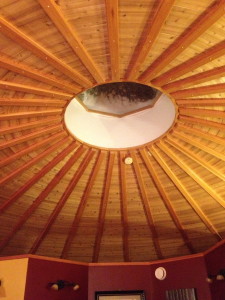 After a few rounds of conversation (too short, but all the time we had), they were invited to move into Presencing. “If it weren’t a cold winter night outside,” I said, “I’d encourage you to move outside for this part. Instead, find a quiet place inside where you can be alone with your thoughts and with whatever wants to emerge.” (As an aside, it felt beautifully appropriate that we were gathered inside a mandala home, a circular home built with great intention around honouring the four directions, giving space at the centre, and blending into the beauty of nature that surrounds it.)
After a few rounds of conversation (too short, but all the time we had), they were invited to move into Presencing. “If it weren’t a cold winter night outside,” I said, “I’d encourage you to move outside for this part. Instead, find a quiet place inside where you can be alone with your thoughts and with whatever wants to emerge.” (As an aside, it felt beautifully appropriate that we were gathered inside a mandala home, a circular home built with great intention around honouring the four directions, giving space at the centre, and blending into the beauty of nature that surrounds it.)
The next phase brought them back to the garbage on the floor, where they began to explore what wanted to emerge. Some felt stuck and really didn’t connect right away with the garbage on the floor. Others were eager to jump in and host the emerging future. Before long, though, everyone had made a valuable contribution to the scale model of the new community that wanted to be born.
We spread our community out on a large piece of cardboard on the table. Some pieces represented a connection with nature, others represented a connection with our neighbours, others represented a connection with opportunities/arts/beauty/etc., and still others represented a deeper connection with self and the sacred.
When we sat discussing the panorama in front of us, we realized that the resounding theme of what was emerging was connection. We were all longing for connection – with each other, with the earth, with the water, with the Sacred, and with ourselves.
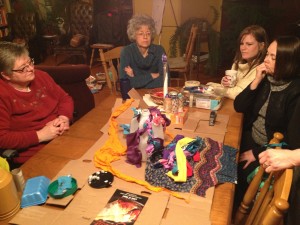 One woman asked “If recycling is the bi-product of a culture of consumption, what can replace consumption as our dominant paradigm that will no longer have a requirement for recycling?” Connection, we agreed. We need deeper connection.
One woman asked “If recycling is the bi-product of a culture of consumption, what can replace consumption as our dominant paradigm that will no longer have a requirement for recycling?” Connection, we agreed. We need deeper connection.
Before we departed for the night, I invited the women to consider (in their private moments, when they were back in their homes) “How might each of us be ambassadors for connection in our communities? How might we begin to invite this future into the circles in which we live?”
The women left with new lights in their eyes that hadn’t been there when they’d entered the room – all because of a pile of garbage and a time of connection.
(Next week’s session flows beautifully out of this… We’ll be talking about making connections in women’s leadership circles, using the new toolkit created by my teachers Christina Baldwin, Ann Linnea, and Margaret Wheatley.)
Note: If you want more inspiration on this, visit Presencing Institute, read Theory U, Presencing, or Walk Out Walk On.
by Heather Plett | Nov 8, 2012 | Uncategorized
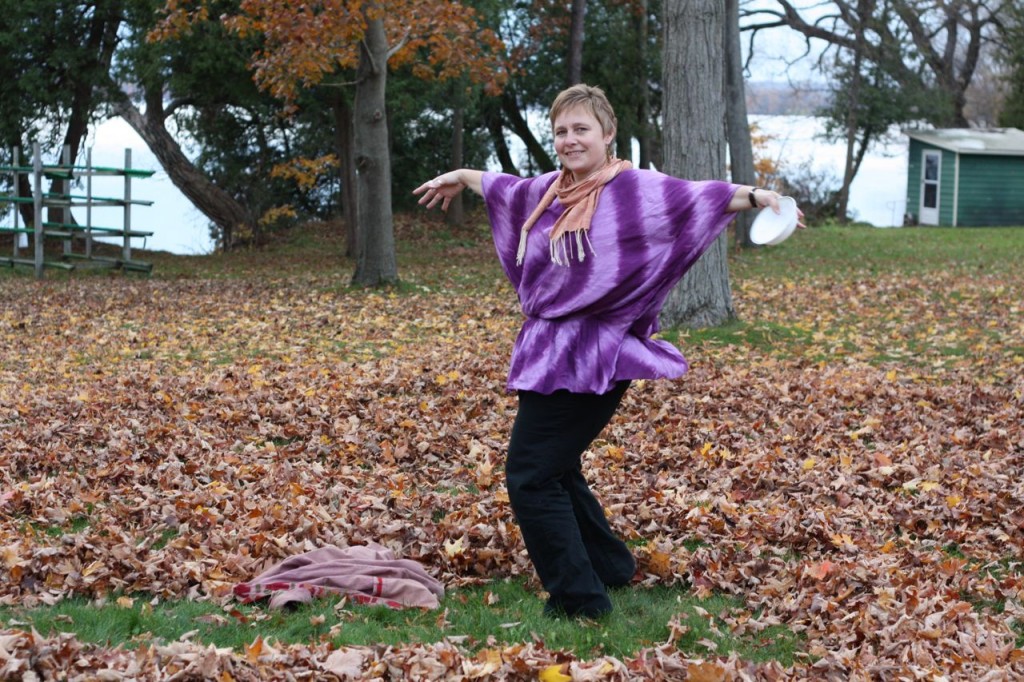
I want to put my heart out on my sleeve
Wear it where the world can see it pulsing.
I want to love wildly. To live vibrantly. To speak daringly.
To laugh until I cry. To cry until I laugh.
I want to believe that my heart can be safe,
Out there in the wild open air.
Pumping life into everything and everyone that needs it.
I want to stop tucking it away when I hear that it is too much for people
That I should be ashamed.
That I should be more fearful.
That I should be silent.
I want to believe that my exposed heart
Will nudge your heart out of hiding
And soon our hearts will all be pulsing together
Giving us the rhythm we can dance to.
I have a big beautiful dream about us – you and me, wild and free.
Living in the mystery of the pulsing of Mother Earth’s heart.
Our hearts in tune with hers. Our blood mingling with hers.
In my dream, we love much, we dare much, we forgive much.
We share because we believe in abundance.
We live simply because we believe we have enough.
We tell stories because we believe in ourselves.
I want to keep dreaming this dream,
Even when my heart gets hurt.
Even when it’s so bruised, I have to tuck it back into my chest for awhile.
Even when I see so much pain, I wonder if the pulsing will stop.
I will be courageous in my dreaming,
Because I know the world needs dreamers.
I will keep putting my heart out there in the open air,
Because I know the world needs wild open hearts.
Want to put your heart out there with me? Let’s learn to lead with our wild hearts.
by Heather Plett | Nov 5, 2012 | change, Community, Creativity, journey, Leadership, Passion
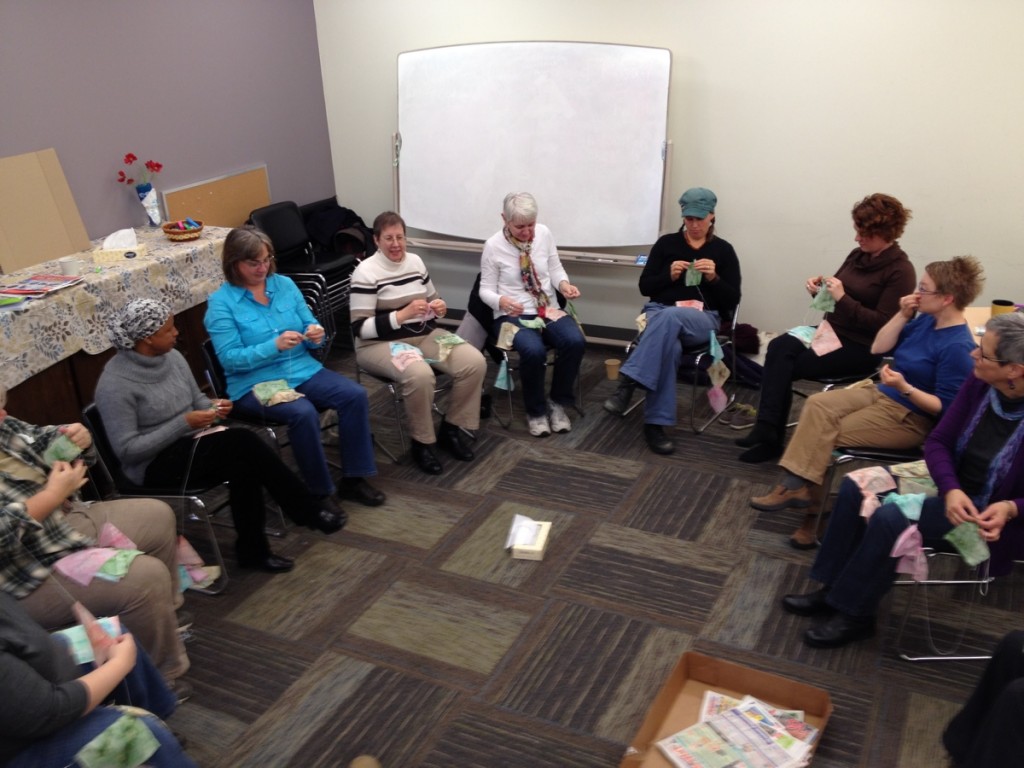
sharing stories and stitching prayer flags at a recent women's gathering
I talk a lot about stories – how important they are in helping us find collective healing, how transformative they can be in encouraging us to dream of a new world, how much they connect us to each other and give us courage.
“But what IS a story?” the students in my Creative Writing for Self-Discovery class pushed back a few weeks ago. “How do you define it? You’ve made reference to the story arc and conflict and plot, but we still don’t know the ‘rules’. How do we figure out whether or not something we write fits the definition of story?”
“Next week,” I promised, and then went home and started brushing up on my definition of story.
When I incorporate storytelling into leadership and personal growth workshops, I purposely leave my definition fairly vague. “A story is simply your account of how things happened. It can be as simple as helping people see a new possibility by telling them ‘when Jim did this last week, it made his daily routine much easier.'” But this was different. This was a group of creative writers who want to master the craft of writing short stories – whether simply for their own enjoyment or for the possibility of getting them published some day.
I did what any teacher would do – I went back to the tried and true definitions from back when I was getting my English degree. I typed up a lovely list of story elements for my students – setting, plot, conflict, character, point of view, and theme. I found a helpful diagram of the story arc that demonstrates how a story moves from routine, through the inciting incident that changes everything, through rising tension, to the climax, and ultimately to the denouement (resolution). I defined the protagonist as the main character and the antagonist as whatever source of conflict arises from the inciting incident which the protagonist must conquer before there is resolution. As I prepared my notes, I had flashbacks of my literature professors (all aging white men, incidentally) drilling it into our impressionable mines that “unless there is conflict and some kind of climax and resolution, THERE IS NO STORY!”
It was all good material that my professors would have been proud of… BUT… it didn’t entirely satisfy me. Something was wrong. Even though it was the kind of handout that would have gotten me an A in my university literature classes, the twenty plus years of wisdom I’ve gained since didn’t quite jive.
Then, while reading A Passion for Narrative, something jumped out and shook me out of my complacent regurgitation. You could say that it was my “inciting incident” where everything changed. It was this quote from Janet Burroway:
“Seeing the world in terms of enemies and warring factions not only limits the possibilities of literature, but also promulgates an aggressive and antagonistic view of our own lives. Further, the notion of resolution is untrue to life, and holds up perfection, unity, and singularity as goals at the expense of acceptance, nuance, and variety… Birth presents us with an alternative model in which there is a desired result, drama, struggle, and outcome. But it also represents a process in which the struggle, one toward life and growth, is natural. There is no enemy. The “resolution” suggests continuance rather than finality. It is persuasively argued that the story as power struggle offers a patriarchal view of the world, and that it would improve both stories and world if we would envision human beings as engaged in a struggle toward life.”
WAIT JUST ONE MINUTE! There’s a different way of defining stories? There doesn’t need to be a protagonist and an antagonist and the struggle doesn’t need to be AGAINST someone or something?
Something new in me woke up. Perhaps more truthfully, something old and primal in me was re-awakened. Suddenly it all made sense, and my storytelling wisdom lined up with my exploration of feminine wisdom.
We’ve been telling too many patriarchal stories! We’ve been letting our old white male university professors convince us that that’s the way it HAS to be! We’ve been conditioned to believe that our stories are not real stories unless there is an evil force to overcome. We’ve sat through hundreds of movies, read thousands of books, and listened to a million children’s stories that have all lead us to believe that there is conflict that needs to be overcome and that the only way to wrap up the story is to tie up the loose ends into some kind of (usually artificially constructed) resolution.
We don’t have to tell those kinds of stories anymore. In fact, the world needs us to start telling NEW stories – ones that are modelled on birth, where there is still a struggle, but this time we are struggling TOGETHER to bring about something new. There is no enemy. And the endings don’t need to be resolved, but rather they leave us at a place of continuance, growth, or just a whole lot of new questions for us to sit with.
This is so much bigger than simply a Tuesday evening creative writing class. This new way of engaging with story is about a new way of engaging with our economy, our religions, our communities, and our earth. It doesn’t have to be about competition anymore. There doesn’t have to be an antagonist in our stories. We can all be protagonists in the struggle together, birthing something new and ending not with a resolution, but with a step into the next story.
It all made sense to me when I read that quote, because THIS is what I feel most called to bring to the world – a new way of telling stories, a new way of walking through struggle, a new way of engaging with each other, and a new way of sensing the future. This is a new story that is actually more like an old story finally being reborn. Patriarchy does not have to rule us anymore. The old stories don’t have to control the way we see the world. We can usher in the Feminine. We can “shake the world with a new dream“. We can redefine ourselves as artists. We can build a new sacred economy. We can lead with our wild hearts.
It’s not easy letting go of the old stories. We’ll experience a lot of pain and resistance along the way. We’ll have to stand up to those wise old university professors and say “we respect your version, and it may have worked in the past, but we’ve got a new story to tell”. We’ll have to stand up to big business and say “you’ve created a lot of good products and you’ve allowed us to live in privilege, but it’s time to stop all this production and birth a new future.” We’ll have to challenge our governments and say “we’ve appreciated the way you’ve let us use our natural resources for our own ease and comfort, but it’s time to stop seeing Mother Earth as the antagonist in this story.” We’ll have to interrupt our meetings and public forums, move the chairs into circle, and say “thank you for leading us in the past, but we have a new way of gathering now and we believe it makes a difference when our chairs don’t mirror a hierarchical view of the world.”
This is what Lead with your Wild Heart is all about. I’ve gathered a Wisdom Circle of people who are willing to share the ways in which they’re learning to tell new stories, and together we’ll be “shaking the world with a new dream” – a dream where there are no enemies, we struggle together, and the end looks more like a set of new questions than a resolution.
I really hope you’ll join me and the other wise women who are starting to gather.








